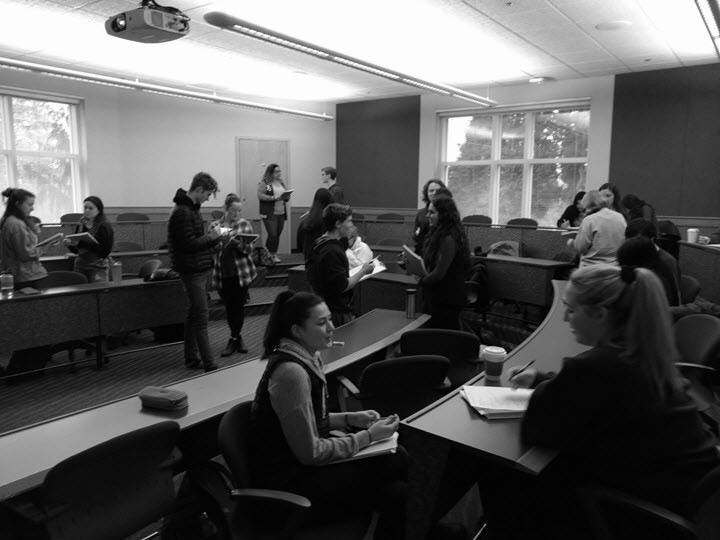 As faculty, we can find ourselves in common patterns of thinking about course planning. We sometimes worry about covering the material. Often we may choose texts and materials first before considering what the intended learning outcomes are. Starting with the outcomes in mind is an important approach, but we may find that the end goal is situated at an overly long distance from where the students actually are. We may find ourselves at times flabbergasted by the gap between what we are teaching and what the students are bringing to the learning experience. What are we to do? In Building a Pathway to Student Learning, Steven Jones, Robert Noyd, and Kenneth Sagendorf (2014) argue that course planning is a design process that starts with focusing on student learning factors. From this first step, the authors provide a helpful systematic framework for course design.
As faculty, we can find ourselves in common patterns of thinking about course planning. We sometimes worry about covering the material. Often we may choose texts and materials first before considering what the intended learning outcomes are. Starting with the outcomes in mind is an important approach, but we may find that the end goal is situated at an overly long distance from where the students actually are. We may find ourselves at times flabbergasted by the gap between what we are teaching and what the students are bringing to the learning experience. What are we to do? In Building a Pathway to Student Learning, Steven Jones, Robert Noyd, and Kenneth Sagendorf (2014) argue that course planning is a design process that starts with focusing on student learning factors. From this first step, the authors provide a helpful systematic framework for course design.
Jones, Noyd, and Sagedorf claim, “An effective pathway for student learning must start with a focus on your students rather than with a focus on your disciplinary content.” Student learning factors may include prior experiences and knowledge, maturity, class standing, cultural background, socioeconomic status, interests, motivation, intellectual development, and more. Such factors can have significant impact on students’ success in the classroom. While we might not have exact knowledge about student learning factors, we can reflect on our students in general and specific ways. For example, any higher education institution is likely to attract certain kinds of students with shared characteristics. In our case, UP students have certain values and that include community, service, and peer relationships. As course designers, we can consider how these values and characteristics affect learning and student interaction in our courses. Other general factors may include trends that we see, such as digital distraction, changes in how students deal with texts, or issues revolving around time management and study skills.
As faculty and course designers, we know of specific student learning factors, too. These include the typical breakdown of students taking our courses by class standing or by major. We know if students take specific courses as a core requirement, a major requirement, or an elective. More specifically, we may know our students personally and thus their habits or mind when taking classes in our departments. As we consider student-learning factors, we can complete this reflection by determining which factors are most significant and likely to have the greatest impact on student-learning success in our courses.
Once we reflect on the projected learning factors of our students, we can move on to the next stages of Jones, Noyd, and Sagendorf’s course design model:
- Setting learning goals
- Determining summative assessments;
- Gauging what intermediate proficiencies will need to be developed to reach the learning goals;
- Main learning experiences for the course;
- Formative assessments used during those learning experiences.
While the authors provide a systematic approach to course design, the process need not be mechanical since we may think of other student learning factors during the design process. When I use this model, I do find myself hopping between stages of the design process though I find it essential that I start with student learning factors. The key assumptions for course design, however, still hold true: All learning is situated, our students bring values, characteristics, and habits of mind to our courses, and it is up to us to take such situated learning and student learning factors into account. So next time you are planning a course, take out a legal pad or journal and start reflecting on your incoming students. To adapt a phrase by the Italian educator Loris Malaguzzi to our higher education context, your image of the student is where teaching begins.
If you would like to meet over coffee or tea and discuss student-learning factors, course design, or Jones, Noyd, and Sagendorf’s model, please feel free to contact me at white@up.edu.
Jeffrey White administers the Learning Commons in BC 163, develops training programs, and trains tutors for the Learning Commons and other programs on campus. He also teaches courses in third-year German, language learner strategies, language tutor training, and “Maximizing Study Abroad” for the Department of International Languages and Cultures. He can be reached at white@up.edu or x7141.
The Learning Commons is a program of the Shepard Academic Resource Center
